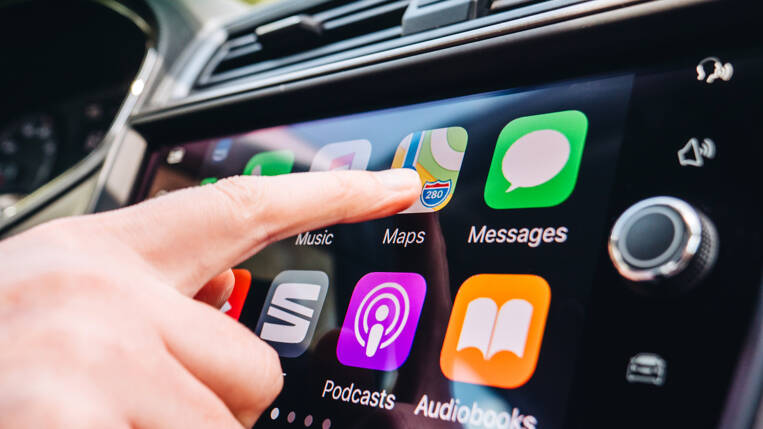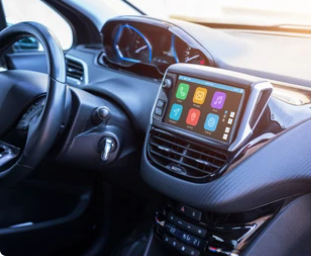Categories: News
Date: June 9th, 2022
Apple CarPlay update: deeper data access announced
Summary
Apple detailed significant updates to its CarPlay platform. The idea is to integrate CarPlay closer to a whole-car interface, not just the phone-mirroring infotainment system like today.
critical: Apple would gain access to a vehicle data. Also Qualcomm (BMW/Volvo/Renault), Intel/Mobileye and NVidia (with Daimler) are following this concept with Infotainmentsystems (and automonous driving).
The user (and Apple) will be able to get access to the cluster and adjust climate controls, activate a seat heater, or tune the radio directly through CarPlay without having to leave Apple’s UI. It will be possible to see (and configure) the current speed, fuel and battery levels, RPMs, navigation details, and other common bits of information in a more unified, highly Apple design.
involved OEMOEM – Original Equipment Manufacturer. More: Apple has entered into cooperations with several car manufacturers for next-generation CarPlay (e.g. Mercedes, Porsche, Audi,..)
Timeline: The first cars supporting the system are expected to be announced at the end of 2023. The vehicles can probably be expected from 2024 onwards.
Details
Only sheet metal benders left: Did the car makers lost the battle against the tech industry ?
CarPlay for everything from 2024
Apple detailed significant updates to its CarPlay platform at its Worldwide Developers Conference (WWDC) on June 6th 2022. During its keynote presentation, Apple gave what it termed a “sneak peek” of the “next generation” of the CarPlay standard, which allows iPhone users to control and view phone-based apps through their car’s dashboard. The company says the update will see CarPlay more deeply integrate with a car’s hardware, allowing it to display info across multiple screens in a host vehicle at a time when more and more cars are integrating more and more displays.

This takeover will allow to do things like adjust climate controls, activate a seat heater, or tune the radio directly through CarPlay without having to leave Apple’s UI. Apple says the software will take over a car’s instrument cluster, so you can see your current speed, fuel and battery levels, RPMs, navigation details, and other common bits of information in a more unified, highly Apple-esque design.
The revamp will provide a range of themes and layouts to customize the look of a car’s instrument cluster, too. Apart from various background colors and dial treatments, for instance, one option displayed speed, gear, and fuel details on top of a street-level navigation view from Apple Maps. The company showcased iPhone-like widget support for apps like Weather, Apple Music, Calendar, and Home, too, which you can access right from the dashboard. According to the company, all of this can adapt to fit different screen sizes within a given vehicle.
Apple didn’t go too deep into the specifics of how the new functionality works during its keynote, merely saying that a connected iPhone will “communicate with your vehicle’s real-time systems in an on-device, privacy-friendly way.” The company noted that it will share more information on the revamped CarPlay “in the future” and that it will start to announce compatible vehicles in late 2023. A slide during Apple’s keynote, however, did list Ford, Mercedes, Nissan, Porsche, Land Rover, Audi, Acura, Honda, Lincoln, Jaguar, Volvo, Renault, Polestar, and Infiniti as car manufacturers that plan to support this “new vision of CarPlay.”

This could become the basis for an operating system for vehicles (carOS).
Special solution for time-critical instruments
One challenge for Apple and automakers is real-time data systems that require the lowest possible latency between collection and display. For example, it would be a hindrance if the speed display had to go through the iPhone first. It is apparently part of the agreement between Apple and the car manufacturers that solutions are found for this in the car and that the display still appears in an Apple design.
Why let Apple take over the system?
The answer lies in the Carplay usage data. If it is present in the car, around a third of drivers use the Apple system. And only four percent of users say they prefer the built-in infotainment system to the one from Apple. In addition, owners of expensive vehicles in particular are more likely to own a new iPhone model.
IT-Tech groups are innovation drivers
Chip manufacturer Qualcomm, for example, has secured BMW, Volvo and Renault as partners. Nvidia is working exclusively with Daimler, and Intel, in turn, is building its technology into a whole range of vehicles through its subsidiary Mobileye. Did manufacturers completely given up on developing their own operating systems for autonomous driving and infotainment ? On the one hand, it’s too expensive, and on the other, many brands have realized that they lack the expertise to do so. However, in a market that is developing at an enormous pace, manufacturers might not have the time/competence to make the transition to a software company.
In the future, even more core competencies of the manufacturers could fall into the IT-Techs hands. Qualcomm, for example, has developed an entire digital chassis that can be applied to all of a group’s vehicle models. Nvidia also has something similar in developement.
Sources

Written by Carmupedia Editorial Office
You might also be interested in
The automotive industry is increasingly leveraging software and data to optimize vehicle safety, performance, and revenue streams, moving beyond traditional hardware-centric models.
Carmunication has started a new Press release. Our new strategy, narrative and ligth-house will be explained.
As part of the Volkswagen Group's New Car strategy, the Cariad subsidiary is developing a group-wide uniform software platform
Protocol to the Advisery Board meeting 25.10.2022.